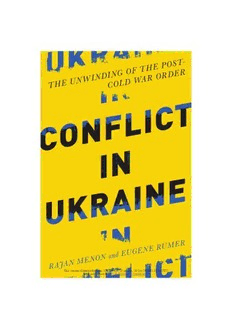
Conflict in Ukraine: The Unwinding of the Post–Cold War Order PDF
Preview Conflict in Ukraine: The Unwinding of the Post–Cold War Order
This content downloaded from 128.184.220.23 on Tue, 20 Oct 2015 02:31:13 UTC All use subject to JSTOR Terms and Conditions Conflict in Ukraine This content downloaded from 128.184.220.23 on Tue, 20 Oct 2015 02:31:13 UTC All use subject to JSTOR Terms and Conditions This content downloaded from 128.184.220.23 on Tue, 20 Oct 2015 02:31:13 UTC All use subject to JSTOR Terms and Conditions Conflict in Ukraine The Unwinding of the Post–Cold War Order Rajan Menon and Eugene Rumer A Boston Review Book The MIT Press Cambridge, Massachusetts London, England This content downloaded from 128.184.220.23 on Tue, 20 Oct 2015 02:31:13 UTC All use subject to JSTOR Terms and Conditions © 2015 Massachusetts Institute of Technology All rights reserved. No part of this book may be reproduced in any form by any electronic or mechanical means (including photocopying, re- cording, or information storage and retrieval) without permission in writing from the publisher. MIT Press books may be purchased at special quantity discounts for business or sales promotional use. For information, please email special_ [email protected]. This book was set in Stone by Boston Review and printed and bound in the United States of America. Library of Congress Cataloging-in-Publication Data is available. ISBN 978-0-262-02904-9 (hc. : alk paper) 10 9 8 7 6 5 4 3 2 1 This content downloaded from 128.184.220.23 on Tue, 20 Oct 2015 02:31:13 UTC All use subject to JSTOR Terms and Conditions To Roger E. Kanet and Oles M. Smolansky (R.M.) and To the memory of Stephen M. Meyer (E.R.) This content downloaded from 128.184.220.23 on Tue, 20 Oct 2015 02:31:13 UTC All use subject to JSTOR Terms and Conditions This content downloaded from 128.184.220.23 on Tue, 20 Oct 2015 02:31:13 UTC All use subject to JSTOR Terms and Conditions Contents Introduction: Ukraine 2014 ix 1 The Making of Ukraine 1 2 Nobody Expected a Crisis 53 3 Impact of the Crisis on Russia 87 4 Europe and the Crisis 107 5 Ukraine’s Prospects 145 6 Conclusion 157 Acknowledgments 163 Notes 165 Index 211 About the Authors 221 This content downloaded from 128.184.220.23 on Tue, 20 Oct 2015 02:33:03 UTC All use subject to JSTOR Terms and Conditions This content downloaded from 128.184.220.23 on Tue, 20 Oct 2015 02:33:03 UTC All use subject to JSTOR Terms and Conditions Introduction: Ukraine 2014 “Crisis” is an overused word, one that has been cheapened as a result. Yet it aptly describes the train of events that followed Ukrainian President Viktor Yanukovych’s decision in Novem- ber 2013 to back away from Ukraine’s Association Agreement (AA) with the European Union. (Ukraine and the EU had begun negotiations on the AA in March 2007; it was initialed, but not signed, in February 2012.1) Yanukovych’s choice proved fateful, for the AA was no ordinary document. It was a symbol of hope for those Ukrainians (well represented in the country’s central and western regions) who dreamed of integrating with Europe, but not for those (chiefly in the south and east) who favored retaining close ties with Russia. Soon, protestors swarmed Kyiv’s streets. Blood was shed fol- lowing Yanukovych’s decision to unleash riot police and snipers to quell the rebellion. This violence merely enraged and enlarged the crowds. By February, with the death toll mounting and his political position perilous, Yanukovych opted for the olive branch. On the 21st, with EU emissaries mediating, he signed a pact with the leaders of the revolt.2 Its provisions included forming a “national unity” government within ten days, prun- ing presidential powers, restoring the 2004 constitution, and This content downloaded from 128.184.220.23 on Tue, 20 Oct 2015 02:55:17 UTC All use subject to JSTOR Terms and Conditions
